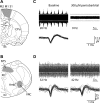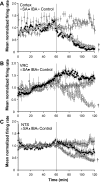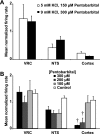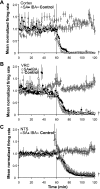Hibernation induces pentobarbital insensitivity in medulla but not cortex
- PMID: 19675281
- PMCID: PMC2763819
- DOI: 10.1152/ajpregu.00239.2009
Hibernation induces pentobarbital insensitivity in medulla but not cortex
Abstract
The 13-lined ground squirrel (Ictidomys tridecemlineatus), a hibernating species, is a natural model of physiological adoption to an extreme environment. During torpor, body temperature drops to 0-4 degrees C, and the cortex is electrically silent, yet the brain stem continues to regulate cardiorespiratory function. The mechanisms underlying selective inhibition in the brain during torpor are not known. To test whether altered GABAergic function is involved in regional and seasonal differences in neuronal activity, cortical and medullary slices from summer-active (SA) and interbout aroused (IBA) squirrels were placed in a standard in vitro recording chamber. Silicon multichannel electrodes were placed in cortex, ventral respiratory column (VRC), and nucleus tractus solitarius (NTS) to record spontaneous neuronal activity. In slices from IBA squirrels, bath-applied pentobarbital sodium (300 microM) nearly abolished cortical neuronal activity, but VRC and NTS neuronal activity was unaltered. In contrast, pentobarbital sodium (300 microM) nearly abolished all spontaneous cortical, VRC, and NTS neuronal activity in slices from SA squirrels. Muscimol (20 microM; GABA(A) receptor agonist) abolished all neuronal activity in cortical and medullary slices from both IBA and SA squirrels, thereby demonstrating the presence of functional GABA(A) receptors. Pretreatment of cortical slices from IBA squirrels with bicuculline (100 microM; GABA(A) receptor antagonist) blocked pentobarbital-dependent inhibition of spontaneous neuronal activity. We hypothesize that GABA(A) receptors undergo a seasonal modification in subunit composition, such that cardiorespiratory neurons are uniquely unaffected by surges of an endogenous positive allosteric modulator.
Figures






Similar articles
-
Changes in ventral respiratory column GABAaR ε- and δ-subunits during hibernation mediate resistance to depression by EtOH and pentobarbital.Am J Physiol Regul Integr Comp Physiol. 2011 Feb;300(2):R272-83. doi: 10.1152/ajpregu.00607.2010. Epub 2010 Nov 17. Am J Physiol Regul Integr Comp Physiol. 2011. PMID: 21084677 Free PMC article.
-
Abrupt changes in pentobarbital sensitivity in preBötzinger complex region, hypoglossal motor nucleus, nucleus tractus solitarius, and cortex during rat transitional period (P10-P15).Respir Physiol Neurobiol. 2015 Feb 1;207:61-71. doi: 10.1016/j.resp.2014.12.016. Epub 2014 Dec 27. Respir Physiol Neurobiol. 2015. PMID: 25550216 Free PMC article.
-
Increased GABA(A) receptor ε-subunit expression on ventral respiratory column neurons protects breathing during pregnancy.PLoS One. 2012;7(1):e30608. doi: 10.1371/journal.pone.0030608. Epub 2012 Jan 31. PLoS One. 2012. PMID: 22303446 Free PMC article.
-
Activation of GABA(A) receptors in subthalamic neurons in vitro: properties of native receptors and inhibition mechanisms.J Neurophysiol. 2001 Jul;86(1):75-85. doi: 10.1152/jn.2001.86.1.75. J Neurophysiol. 2001. PMID: 11431489
-
GABAergic effects on nucleus tractus solitarius neurons receiving gastric vagal inputs.J Pharmacol Exp Ther. 1998 Aug;286(2):736-41. J Pharmacol Exp Ther. 1998. PMID: 9694928
Cited by
-
Changes in ventral respiratory column GABAaR ε- and δ-subunits during hibernation mediate resistance to depression by EtOH and pentobarbital.Am J Physiol Regul Integr Comp Physiol. 2011 Feb;300(2):R272-83. doi: 10.1152/ajpregu.00607.2010. Epub 2010 Nov 17. Am J Physiol Regul Integr Comp Physiol. 2011. PMID: 21084677 Free PMC article.
-
Daily isoflurane exposure increases barbiturate insensitivity in medullary respiratory and cortical neurons via expression of ε-subunit containing GABA ARs.PLoS One. 2015 Mar 6;10(3):e0119351. doi: 10.1371/journal.pone.0119351. eCollection 2015. PLoS One. 2015. PMID: 25748028 Free PMC article.
-
Abrupt changes in pentobarbital sensitivity in preBötzinger complex region, hypoglossal motor nucleus, nucleus tractus solitarius, and cortex during rat transitional period (P10-P15).Respir Physiol Neurobiol. 2015 Feb 1;207:61-71. doi: 10.1016/j.resp.2014.12.016. Epub 2014 Dec 27. Respir Physiol Neurobiol. 2015. PMID: 25550216 Free PMC article.
-
Increased GABA(A) receptor ε-subunit expression on ventral respiratory column neurons protects breathing during pregnancy.PLoS One. 2012;7(1):e30608. doi: 10.1371/journal.pone.0030608. Epub 2012 Jan 31. PLoS One. 2012. PMID: 22303446 Free PMC article.
-
Suppression of neurons in circumventricular organs enables months-long survival without water in thirteen-lined ground squirrels.Science. 2024 Nov 29;386(6725):1048-1055. doi: 10.1126/science.adp8358. Epub 2024 Nov 28. Science. 2024. PMID: 39607925 Free PMC article.
References
-
- Adamos DA, Kosmidis EK, Theophilidis G. Performance evaluation of PCA-based spike sorting algorithms. Comput Methods Programs Biomed 91: 232–244, 2008 - PubMed
-
- Bonham AC, Chen CY, Sekizawa S, Joad JP. Plasticity in the nucleus tractus solitarius and its influence on lung and airway reflexes. J Appl Physiol 101: 322–327, 2006 - PubMed
-
- Carey HV, Andrews MT, Martin SL. Mammalian hibernation: cellular and molecular responses to depressed metabolism and low temperature. Physiol Rev 83: 1153–1181, 2003 - PubMed
-
- Carey HV, Martin SL. Preservation of intestinal gene expression during hibernation. Am J Physiol Gastrointest Liver Physiol 271: G805–G813, 1996 - PubMed
-
- Carey HV, Potter KT, Peters TL, Epperson LE, Rose JC, Martin SL. Hibernating mammals have enhanced survival and reduced gut damage after hemorrhage. FASEB J 20: Abstract no. 903.1, 2006
Publication types
MeSH terms
Substances
Grants and funding
LinkOut - more resources
Full Text Sources

